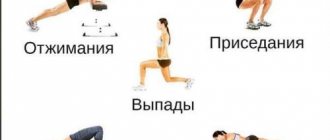After a long break, returning to training sessions is not easy; you need to know a number of nuances to make such a return to the gym pleasant and painless.
Usually, after a long break, an athlete begins training in the gym with double energy - this is a serious mistake.
Such a desire is psychologically justified and constructive, but you need to adhere to several principles in order to quickly return to your former physical form and not harm the body.
Maintain personal balance
Among wellness trends, self-care is coming to the fore.
According to statistics, nervous breakdowns and depressive states are being diagnosed in 35% more people compared to last year. Therefore, the main thing that all adherents of a healthy lifestyle care about is the search for personal balance. This means that it is important to spend less time on social networks in order to give up like addiction and learn to take a break from everyone. Experts advise not to be afraid to travel or go to a restaurant alone. This will help not only relax, but also find harmony with yourself.
The best workouts for the first day after a long break

HeungSoon/Pixabay
If you're ready, it's time to start training. We've handpicked six workouts that are perfect for your first (or second) day of training after a long break.
1. Body exercises
Do this 15-minute workout that requires zero equipment. Too easy? Add more sets and less rest time between exercises to get more benefits from your workout.
2. Free weights
Try training with free weights. It's just deadlifts, squats, overhead presses and biceps curls. Lighten the weight than usual since it's your first day so you won't be sore later.
3. Gym
For the first days of training, and even then, cardio equipment is better suited. They will help you build up your endurance and prepare you for more work later. If you don't know which gym equipment to choose, here's a guide to cardio equipment.
4. Running or cycling
Parks and squares in the spring will be full of running people who are trying to lose weight or stay in shape. Running is good for your health as well as your body. If you haven't exercised for a long time, running is the best thing you can do to start your new fitness journey. Before you start running, you just need to know how to run correctly to avoid injuries.
In addition, cycling will be useful. Try to go for a walk every day, at least for a little while. If possible, ride your bike to work. This is an ideal option to get used to heavy loads.
5. Zumba
There is nothing more fun than Zimba, which entertains and tightens your body in dance. There is nothing stopping you from setting aside 5 to 10 minutes for your workout. Over time, these mini-workouts turn into something more. You will have a desire to do more exercises and spend more time training. So be sure to check out the 7-Minute Zumba Workout.
6. Yoga
This Yoga Basics workout with Kino MacGregor is designed for beginners, so it's a great way to get started or learn the basics of yoga. This is a short video of 12 minutes, so if you want more, then add some more yoga asanas for beginners that help you lose weight.
Dressing for WFH

Source: Pexels
WFH (work from home) is a special dress code that has become a new trend for people whose office has become their home (and there are more and more of them since the beginning of the pandemic). Working from home in pajamas, a robe or stretched sweatpants is not a good idea. WFH is comfortable, but not too formal clothing, in which you can conduct a Zoom meeting or write a quarterly report much more productively.
The harm and benefits of breaks in sports
As you already understand, the effect of breaks in sports on the body directly depends on their duration. However, they can have both negative and positive effects on muscle condition. Let's start with the benefits of breaks in sports. Let's talk about breaks that are within acceptable limits, namely those that last no more than a month. During this period, your muscles will have time to fully recover, your body will gain new strength and energy, thanks to which you will be able to begin physical activity again. In addition, a break from sports can be an excellent reason to change physical activity and try a new sport.
Now let's talk about the dangers of breaks in sports. As mentioned earlier, one of the most significant problems associated with stopping training is a decrease in muscle mass. If your goal is a beautiful, sculpted and toned body, then a break can lead to a complete loss of existing results and force you to start all over again, reducing all previously made efforts to nothing. Another danger of long breaks in sports is weight gain. The fact is that instead of muscle tissue, which is rapidly decreasing, fatty tissue will appear, which negatively affects the condition of the figure. To prevent this, even in the absence of regular exercise, you must continue to monitor your diet, eating exclusively healthy and low-calorie foods.
Stay in vegan hotels

Source: @saorsa1875
Not only hotels where the menu offers original dishes made from vegetables and cereals are called vegan, but also those where materials of animal origin - wool or silk - are not used in the interior. So-called second-city travel is especially popular.
This term denotes a holiday that is different from the usual urban tourism. You should not choose the capital of the country with the most famous attractions, but small cities where you can truly feel the local flavor.
What happens if you miss one workout?
As a rule, many gym goers work out 2-3 times a week. Any specialist in the field of fitness and bodybuilding will tell you that this amount of training is quite enough to build muscle and increase strength. Quite often it happens that for some reason (for example, due to illness or being overwhelmed at work/study), a person is unable to come to the gym and fully train. Will his physical performance change significantly if he misses one lesson?
Experts say that such a single absence will not affect the athlete’s results at all. Having missed one workout, he will not lose the same muscle tone and will be able to return to training again, working out at the same pace as before. Moreover, if an athlete trains more than three times a week, then such rest will even be useful for him: the muscles will have time to recover properly, and it is quite possible that in the next session he will be able to demonstrate even better results than before. First of all, this applies to strength training with additional equipment. Both professional athletes and doctors agree that in some cases it is better to undertrain than to overtrain. Exhaustive work can not only kill the motivation to engage in iron sports, but also lead to serious injuries that can take years to heal.

Stick to clean eating

Source: Pexels
Clean eating is another trend that all healthy lifestyle followers are following. This term means a conscious approach to food and an emphasis on organic foods that are as rich in vitamins and nutrients as possible.
It’s even better if it’s local food with minimal processing. This is a new level of healthy lifestyle, which followers of healthy eating pay special attention to. For example, the global trend is alternative (or plant-based) milk. It can be used to add to smoothies, coffee or breakfast cereal. Second in line is alternative flour. Not so popular yet, but actively gaining momentum.
Dream

Just as training and nutrition are important to your performance, so is sleep. It is during sleep that those biochemical processes and reactions take place in the body during which healing and increase in muscle fiber size occur. That is, your muscles do not grow in the gym, but during sleep. Recovery rest between workouts proceeds as follows. During training, you injure your muscles, while eating, you load your body with building material, which performs its functions during sleep and due to this, your muscles grow and increase in size. It is quite natural that if you do not get enough sleep, your muscles will not grow. Even if you only miss an hour or two of sleep, it will ultimately affect your training and results. In the case when you sleep little at all, there can be no talk of any result from your training. The best conditions for muscle growth will be those in which you can afford to sleep a little more than usual, thus increasing the rest time between workouts. It’s even better if you get up not because you were woken up, but on your own. To do this you will have to adhere to a certain regime. Go to bed at the same time every day in order to adjust your biorhythms as needed.
A little more than usual, how much? Before answering this question, we will once again remember that each person is individual by nature and everyone will have their own time for sleep. Sleep, which is directly included in the rest between workouts, can take someone even four hours in order to feel well-rested. Some people need six, some eight, some ten. At the same time, we all know from childhood that the average is eight hours of sleep. This is true in most cases, but does not take into account the individual need for sleep, depending on a person’s lifestyle, type of activity, level of physical activity, and a great many other factors. So, what figure will we start from? Everyone will choose this figure individually, and the recommendation will be as follows.
Try to increase the rest time between workouts that you usually spend sleeping by one hour, or at least half an hour. But you don’t need to strive for such a figure right away. Try gradually increasing your sleep duration by 15 minutes once a week. Let's say if you start working out in the gym, your need for sleep will increase, therefore, you will have to spend more time sleeping. If you previously spent 6 hours sleeping, try to gradually increase this time period. First, in the first week up to 6 hours 15 minutes, in the second up to 6:30, in the third up to 6:45 and ultimately, in the fourth week, that is, a month from the start of the experiment, you will have to increase your sleep time until 7 o'clock. But remember that you should not do anything suddenly, as this will be stressful for the body. Increase your sleep time gradually to best adjust your body clock to your new routine.
What will such an increase in sleep give us? In terms of muscle, such an increase will significantly increase your biological needs for recovery in general and, accordingly, more time will be spent on muscle growth. This means that you will best provide your muscles with favorable conditions for growth. Recovery between workouts will be more favorable, and its effectiveness will increase significantly.
How to achieve such an increase in sleep time? Simple enough. In the evening after work or school, do not sit too long in front of the computer or TV. Remember. Only long and sound sleep will allow you to fully realize your potential.
Don't forget about time for yourself
In the modern world, when every person has a job, family and children, it is difficult to find time for yourself. But adherents of a healthy lifestyle are sure that without Me Time it is impossible to maintain mental health.
It is important that dates with yourself are beneficial. This could be a workout for health, not for a figure, a beauty bath or meditation.
Principles of healthy lifestyle recovery
- Set up your daily routine: nutrition, training, rest and work. Start your morning with a glass of water, and 10-15 minutes later - a hearty breakfast. Stay hydrated throughout the day. Eat at least six small meals a day, try to include more fiber, vegetables, and low-fat steamed foods in your diet.
- Avoid extremes. Do not make sudden changes in nutrition, training and daily routine. If you constantly overeat, then do not suddenly switch to a series of fasting days. So there is a risk of breaking down. In training, adhere to the same principle - everything should be in moderation. Start by creating a simplified version of the training program for the first week of adaptation. This way you will help the body gradually enter the training process. The length of your break from classes plays a big role in drawing up your plan.
- Start thinking positively to improve your psychological background.
After a long rest from physical activity, muscles, joints and ligaments lose their usual trained tone. Therefore, the first workout after a break is a lot of stress for the body. This means you need to thoroughly prepare for it.
Use additives

Source: Pexels
To feel good even while in the rhythm of a big city, real health workers closely monitor their diet. They also use various supplements to saturate the body with useful substances and look good even without makeup.
Among the most common dietary supplements are collagen, chlorophyll, Omega-3, hyaluronic acid, and adaptogens.
Give up alcohol

Source: Pexels
If you want to live like true adherents of a healthy lifestyle, you must say goodbye to alcohol forever. And the point here is not even about harm to health, although not without it. When you drink a glass or several, it's like you're taking credit from yourself.
By liberating yourself, you become who you want to be. But in the morning the harsh hour of reckoning comes. Challenge yourself and forget about alcohol as if you don’t want it at all. To avoid being completely sad, replace millet with kombucha - and life will sparkle with new colors.
The effect of breaks in sports on the body
In order to create a program for restoring muscle mass and returning muscles to tone, you need to know exactly how a break in sports affects your body. The consequences of interruptions will vary depending on their duration.
A week
If the break between the last and next workout is a week, nothing bad will happen to the muscles. They begin to lose their strength, elasticity and shape only ten days after stopping sports. Over the course of a week, muscle tissue gradually recovers from damage, especially if the training was particularly intense, so a week-long break may even be beneficial. The main thing is not to delay returning to training, since with each subsequent day it will be more and more difficult to get back into shape. Therefore, you can safely go on vacation without worrying about your appearance and shape. In some cases, after such a break, there is even a rise in strength and a surge of energy, so necessary for training.
Month
If the break between workouts lasts a month, the physical capabilities of the muscles begin to decline. The body weakens, fully recovered muscles stop regenerating and, therefore, their growth stops. This leads to a decrease in muscle strength and a decrease in their volume. In addition, endurance deteriorates due to a decrease in the amount of glycogen in the muscles during periods of non-exertion. But despite this, it is possible to get back in shape after a month-long break by putting in a little effort and properly planning your workout, including basic exercises that involve the maximum number of muscles.
A few months
A break of several months or more is fraught with loss of muscle memory, which is responsible for rapid muscle recovery. These changes occur at the nervous system level, changing and weakening muscle coordination. You can recover quickly after such a long break only if your sports experience is long enough, and most of the movements and exercises have been practiced to the point of automatism. This is called a motor skill that stays with us almost for the rest of our lives, and you don’t have to re-accustom your muscles to loads.
A year or more
After a year-long break from sports, the body returns to its original shape, which you had before you started regular physical activity. If you do not resume training, then no further changes occur in the muscles; they no longer recover and grow, stabilizing in the form necessary to perform basic motor functions used in everyday life. In order to regain your lost shape, you will need to start all over again, starting classes from the initial level.











